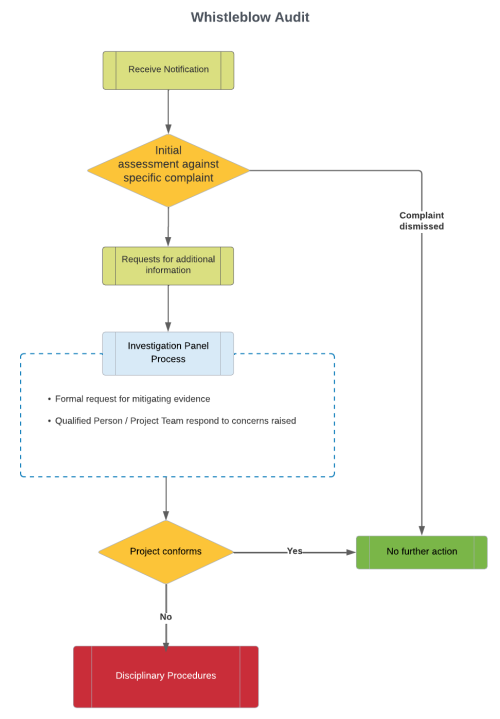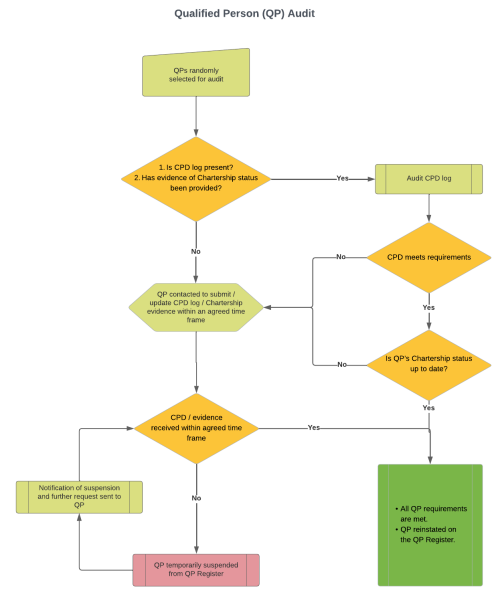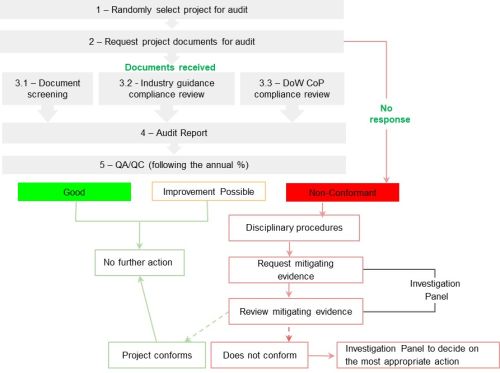Introduction
The Definition of Waste: Development Industry Code of Practice (DoW CoP) sets out good practice for industry to follow in the management of excavated materials. It describes an auditable system to demonstrate that the DoW CoP has been applied correctly. CL:AIRE introduced the auditing of projects applying the DoW CoP in 2019 to support its commitment to maintaining and improving industry standards.This work comprises 3 types of audits:
- Ongoing Project Audits: continuous, randomised auditing of Projects applying the DoW CoP.
- Whistleblower Audits: targeted auditing of Projects applying the DoW CoP, which have been flagged to CL:AIRE by a concerned third party.
- Qualified Person (QP) Audits: annual auditing following the QP renewal period, to ensure requirements of the QP role are met.
To provide users of the DoW CoP with more transparency and an understanding of what to expect when selected for audit, the following pages provide a summary of the auditing procedures followed by CL:AIRE.
Ongoing Project Auditing Procedures
1. Randomly select project for audit
1.1. Auditing is carried out on an annual basis.
1.2. Projects will be randomly selected from the preceding year’s:
- completed projects (those which have submitted a Verification Report), and
- projects with outstanding VRs (those which have not submitted their report by the date indicated in the Declaration and have not responded to any reminders).
1.3. Number of selected projects (sample size) will be proportionally representative of the number of scenarios in the selection pool described in section 1.2 of this procedure.
2. Request project documents for audit
2.1. The Project Team representative (by default the person who submitted the Verification Report) will be contacted to either:
2.1.1. upload the project documents following the provided instructions; or
2.1.2. provide alternative relevant contact details for the Project Team.
2.2. As a minimum CL:AIRE expect the following to be submitted for audit:
- Materials Management Plan;
- Desk Top Study / Site Investigation Reports (for both Donor and Receiver sites);
- Risk Assessment;
- Remediation Strategy / Design Statement (depending on whether Route A or Route B);
- Verification Plan;
- Tracking system;
- Mass balance calculations;
- Communication pack (liaison with Local Authority / Regulator etc.); and
- Verification Report (usually uploaded to the CL:AIRE website as part of CL:AIRE’s Verification Report procedures), or
- in the event that the project is still ongoing, an equivalent of “Interim Verification Report” (summarising the project’s most recent updates) will be required as part of the audit documentation.
2.3. The Project Team will be asked to identify the documents they wish to be considered for audit on a DoW CoP Audit Request Document Reference Form.
3. Assess Documents
3.1. Tier 1 - Document screening (~10% of the audit work).
3.1.1. Checking all required documents have been submitted.
3.2. Tier 2 – Industry guidance compliance review (~15% of audit work).
3.2.1. Reviewing the supporting documentation against relevant industry guidance / standards (Land Contamination Risk Management (LCRM), July 2023; BS 10175:2011+A2:2017; and BS 5930:2015+A1 2020 etc.).
3.3. Tier 3 - DoW CoP compliance review (~75% of the audit work).
3.3.1. Assessing how well the project accords with DoW CoP requirements as set out in the DoW CoP Main Document, Version 2, March 2011 and the DoW CoP FAQs.
4. Audit Report
4.1. The Audit Report documents the project audit.
4.2. The individual lines of evidence and supporting documents / reports are each graded on how well they accord with the DoW CoP and relevant industry guidance. From this, an overall grade is assigned to the project.
4.3. There are currently three grading categories (Good, Improvement Possible and Non-Conformant); the description for each is provided below in Table 1.
Table 1 Current Grading System
|
Good |
● All documents present; ● Documents accord with guidance; and ● All DoW CoP requirements met and exceeded. |
|
Improvement Possible |
● All documents present; ● Documents generally accord with guidance; ● Minimum DoW CoP requirements met. |
|
Non-Conformant |
● Missing significant documents; ● Documents repeatedly do not accord with guidance; ● Minimum DoW CoP requirements not met; or ● Project falls outside of the scope of the DoW CoP. |
- Quality Assurance and Quality Control (QA / QC)
- 5.1. A proportion of the projects selected for audit undergo a QA / QC review.
5.2. There are two types of QA / QC review:
5.2.1. Internal review:- undertaken by a senior member of staff at CL:AIRE;- notes and observations are available to the reviewer; and- approximately 30% of the total number of audits completed are reviewed
5.2.2. External review:- undertaken by an experienced, independent reviewer;- blind review - no notes or observations from the initial audit are available to the reviewer; and- approximately 5-10% of the total number of audits completed are reviewed.
5.3. Discrepancy review
5.3.1. Any discrepancies between the original grading and the QA / QC grading(s) are discussed, and a final grade is agreed upon.
- Outcomes and Feedback
6.1. For projects that are graded as ‘Good’ or ‘Improvement Possible’, no further action is taken.
6.2. Projects that do not reply to audit requests and that are found to be ‘Non-Conformant’ may trigger the use of CL:AIRE’s Qualified Person or Project Team Disciplinary & Grievance Procedures.
6.3. CL:AIRE does not provide specific feedback to Project Teams or QPs on the outcome of the audits.
6.4. Generalised feedback will be provided in an annual Audit Report which will be made available to the industry.
6.5. All audit outcomes are made available to the regulators on request.
Whistleblower Auditing Procedures
- Receipt of Notification and Initial Assessment
- CL:AIRE can receive a notification of a project that may have incorrectly applied the DoW CoP via CL:AIRE’s Help Desk.
- Concerns may be raised by:
- the Regulator (Environment Agency, National Resources Wales, Local Authority);
- industry; or
- a concerned third party.
- An Investigation Panel is set up to conduct an Initial Assessment of the complaint.

- In order to undertake an Initial Assessment CL:AIRE will require, as a minimum, the following:
- site address including postcode, or National Grid Reference (Declaration timestamp if known);
- the non conformance issue; and
- the person / organisation that raised the issue.
- All details are held by CL:AIRE in confidence.
- The Investigation Panel may request additional information from the Qualified Person and / or Project Team to inform the Initial Assessment.
- A decision is made to either dismiss the complaint or proceed with the Investigation Panel Process in line with CL:AIRE’s Qualified Person and Project Team / User Disciplinary and Grievance Procedures.
- Formal Request for Mitigating Evidence
- If the concern that has been raised occurred after the submission of the Declaration, the Qualified Person will be contacted for the details of the Project Team so that CL:AIRE can liaise with them directly.
- The Qualified Person and / or Project Team are contacted and informed of the concerns that have been raised. They are requested to coordinate a formal response and submit specific mitigating evidence and / or the full project documents for an audit, if required.
- The nature of the concern(s) will influence the type of mitigating evidence that is likely to be submitted. For example (non-exhaustive):
- gate fees without regulatory agreement / approval - contingency arrangements and contracts;
- movement of material in advance of a Declaration - tracking system and consignment tickets;
- excavation of material in advance of a MMP - appropriately dated MMP and site logs;
- brownfield materials moved under a Direct Transfer - a review of the Donor Site Site Investigation (logs & lab results), material acceptance records, validation testing and photographs;
- numerous concerns identified or more clarity required - MMP and all associated project documents to enable a full audit.
- Investigation Panel
- In line with CL:AIRE’s Qualified Person and Project Team / User Disciplinary and Grievance Procedures, the Qualified Person’s and / or Project Team’s response, along with any mitigating evidence submitted, will be reviewed by an Investigation Panel.
- Where a decision is taken to conduct a full project audit, the audit findings will also be taken into consideration.
- The Investigation Panel will decide on the most appropriate course of action and may decide to:
- dismiss the complaint (if the project is found to conform with the DoW CoP);
- seek to resolve the issue without requiring more formal procedures; or
- decide to hold a Disciplinary Meeting.
- The following will also be taken into consideration when deciding on the appropriate action:
- minor / first offence - most likely a warning letter issued; or
- second offence / gross misconduct - potential for the offender’s future use of the DoW CoP to be restricted, as per the disciplinary procedures.
- The outcome of the audit will remain on CL:AIRE’s records and will be taken into account in the event of further transgressions by a Qualified Person or Project Team.
- CL:AIRE does not replace the role of the regulator and the extent to which CL:AIRE can act is described within the Disciplinary and Grievance Procedures. Furthermore, the regulators may, and frequently do, carry out their own auditing works.
- All audit outcomes are made available to the regulators on request.
Qualified Person (QP) Auditing Procedures
- Requirements of the QP Role
- As part of the registration process all new Qualified Persons (QPs) are required to pass an Online Assessment.
- Re-testing every 5 years is a requirement for all current QPs to ensure knowledge of the DoW CoP is maintained.
- Annually, QPs are required to log a minimum of 30 hours of Continued Professional Development (CPD) on the planning, management, regulation or oversight of DoW CoP, remediation or other projects involving materials management.
- QPs can either log their CPD directly on the CL:AIRE system, or to avoid duplication, simply upload their logs recorded on alternative platforms.
- QPs are required to have active Chartered status from an appropriate professional body.
- To remain active, QPs are required to renew their QP status annually.

- As part of the registration process all new Qualified Persons (QPs) are required to pass an Online Assessment.
- Selection of QPs for Audit
- QP audits are carried out annually.
- Approximately 10% of Qualified Person Renewals are randomly selected for audit.
- Selected QPs are checked against the previous year's audit to ensure individuals are not audited in consecutive years.
- QP Audit
- The audit first checks whether the QP’s CPD log is present on the CL:AIRE system.
- The procedure followed when a CPD log is missing or QP requirements are not met is detailed in section 4 below.
- The QPs CPD log is reviewed and the audit assesses:
- If the CPD log was uploaded on time;
- If the minimum number of CPD hours have been achieved;
- If the logged CPD is appropriate and relevant to the DoW CoP; and
- If the QP has provided adequate detail of the activities logged.
- Where QPs have two previous failed attempts at the QP Online Assessment, the audit considers if any agreed additional CPD hours have been met.
- The QP’s evidence of active Chartered status is checked to ensure it is up-to-date.
- The audit first checks whether the QP’s CPD log is present on the CL:AIRE system.
- Outcomes
- If a QP has not uploaded their CPD log, or does not meet the QP requirements, they will be contacted to agree a time frame in which they can submit / update their CPD log / Chartership evidence.
- If the QP’s CPD log / evidence is not received within the agreed time frame, the QP will be temporarily suspended from the QP Register.
- The QP will be notified of the suspension and asked to provide the required information.
- The QP should update their CPD log or provide any required evidence and inform CL:AIRE once they have done so.
- The CPD log / Chartership evidence will be reviewed (as per section 3. above) and if satisfactory the QP is reinstated to the QP Register.
- Audit outcomes are held on CL:AIRE’s records.

